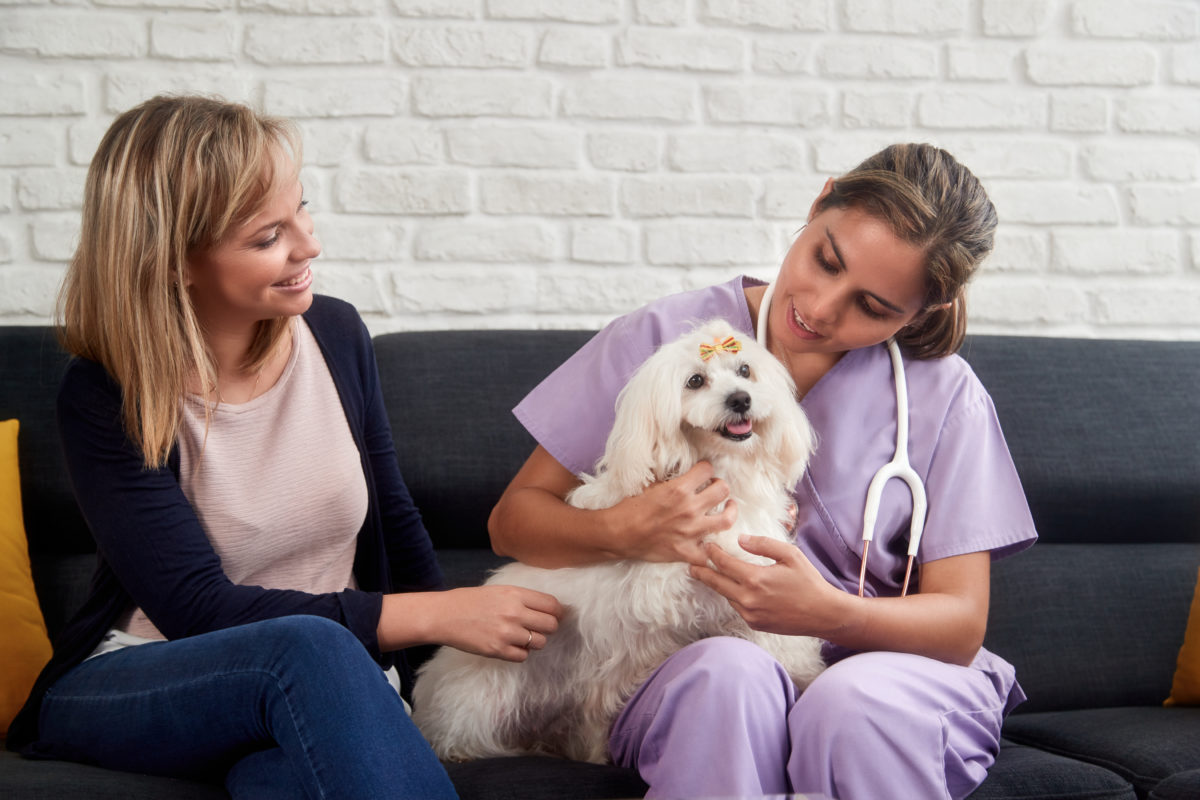By Amy Shojai, CABC, Fear Free Certified® Professional
Pet owners may object to having their animals “taken to the back.” Here’s what to consider when deciding whether it’s necessary.
Jill Breitner, a former vet tech and Fear Free certified professional and dog trainer, frequently writes about pet issues. She has also trained vet techs on low-stress handling techniques. When her 8.5-pound dog Timber recently ate a guest’s dark chocolate candy bar, they hurried to the emergency clinic.
As vitals were taken, Breitner used Fear Free techniques to restrain Timber and even talked with the veterinarian about the program. “I asked to be in the room for the injection to induce vomiting,” Breitner says. The vet pushed to take Timber “to the back” for immediate treatment instead, arguing that Breitner might have to wait an hour for treatment if she insisted on being present. “That made no sense to me,” Breitner says.
After she pressed for an explanation, the upset vet walked out. Anxious to get Timber the care she needed, Breitner threatened to write about her bad experience. “Within three minutes, the veterinarian and a tech were back in the exam room with the drug injection to induce vomiting,” Breitner says. Within two minutes, Timber brought up the chocolate, wrapper and all.
Why Pet Parents Object
There may be good reasons for treating patients “in the back” but many pet parents object and have valid concerns. For Fear Free practices, it is incumbent to acknowledge these concerns, provide explanations, and perhaps take a closer look at ways to reduce fear, anxiety, and stress in both pets and pet parents.
Pets are calmer. Many veterinarians believe pets act calmer without the owner present. In some instances, this is true. Yowling cats fall silent, and struggling pups go limp. Others argue, however, that certain pets seem calm only because they’ve shut down out of fear. Motionless doesn’t equal fear free.
At the same time, very protective or sensitive dogs may become more upset by their owner’s emotional state. Veterinarians must be able to evaluate each individual situation.
Restraint issues. It’s true that not all pet parents know how to safely and effectively restrain pets in a stress-free manner. There may also be liability issues if someone is bitten.
Breitner says, “It would be appropriate in an emergency, life or death situation needing immediate attention. Still parents can ask that the dog be sedated in their arms, before they bring them to the back, even at this time of emergency. Pets feel safer and less fearful with their parents.”
When concerned about proper restraint, pet parents can still be present perhaps by holding a lickable treat while the staff restrains and performs the treatment. Teach clients how to distract, gently restrain, and restrain animals for less stressful future visits for all involved.
Staff discomfort. Having the pet parent present may raise the practitioner’s FAS level. It may take longer to perform a blood draw, for example, when the owner inadvertently interferes. Maybe the vet worries about getting the perfect needle stick with a non-professional audience. As a former vet tech, I’ve assisted in many surgical procedures, but it’s different when the patient is your own animal. Very few clients have the temperament to witness surgery on their own pets, but may still be eager to be with them up until sedation takes effect.
Equipment access. The standard clinic design can make the back a much more convenient location for treatment. Staff has ready access to proper lighting, sinks, supplies, emergency equipment, and more.
Exam rooms that are tiny and awkward to maneuver in can make large dogs feel trapped. Open spaces of “the back” reduce this stress. There may also be insurance concerns that prevent non-clinic personnel from entering certain areas. Radiographs, for instance, require protective gear and exposure data records.
Habit. The trend to take pets to the back appears to be a uniquely American veterinary habit. If you’ve always done it that way, it’s time to explore other options. In fact, some pets do much better with their owners present. Cats and dogs may be given vaccines while on a pet parent’s lap as a treat is offered, or even in the waiting room in certain instances.
How to Make it Work
Communication is key, as is mutual respect. Pet parents have become more educated and are learning to be better advocates, Breitner says. Nobody wants to resort to threats to make themselves heard, and it’s unfortunate when veterinarians feel put on the defensive. Find out what clients want and expect.
Ask if a cat or dog does better or worse with them present. Is the client phobic about seeing needles or blood, or so upset they’re not helping the situation? Does someone have special skills—a dog trainer, perhaps? Are they familiar with low-stress handling?
Breitner agrees that communication goes both ways. She suggests that pet parents plan for time to wait or offer to reschedule during a less busy time to make it easier to stay in the room with the animal.
When your professional opinion means taking the pet “to the back” offers better treatment options and less stress, explain why. Think about offering the option to come to the back with the animal.
“When vets listen better, they can communicate better,” Breitner says. “This relationship of trust between parent, pet, and vet goes a long way toward ensuring that their patients and clients feel safe while in the clinic.”
Every pet parent and animal is different. Being inflexible about your procedures may actually increase FAS in the animal and the owners—and you. It may also hurt your practice when clients choose to stay with their animals and walk away from your practice.
This article was reviewed/edited by board-certified veterinary behaviorist Dr. Kenneth Martin and/or veterinary technician specialist in behavior Debbie Martin, LVT.




